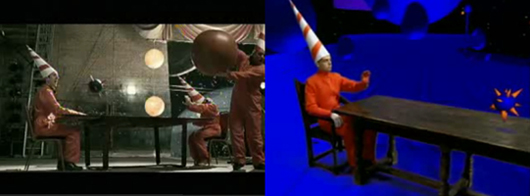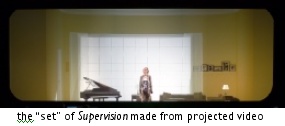In 2004, as the Matrix Ping Pong video link bounced its way from inbox to inbox, people where amused by the re-creation of a ping pong match with Matrix style special effects, using people instead of computer technology. Viewers were amazed at the elaborate costumes, only to be topped by even more amazing choregraphy. Perspective changes and camera angles are reproduced. Influences of Matrix 360 camera spinning and earlier Cantonese martial arts films are pervasive. Part of its success was the evident work and planning that was required to design and execute the scene. The idea of simulating the simulated was both ingenious and topical. However media criticism aside, it’s just a pleasure to watch.
The clip comes from a popular Japanese television show Kasou Taishou, where contestants performs skits before a panel of judges. These skits often involve re-creating camera work and special effects of film. That same year, Neil Tennant and Chris Lowe of the UK pop band Pet Shop Boys release the video for the song “Flamboyant.” In the video, a (stereo)typical Japanese corporate employee is seen struggling to design a skit for the show. Interspersed in the video are mock Japanese ads starring Tennant and Lowe. Two years later, they take the idea one step further recently their their new video, for “I’m with Stupid.” In it, Matt Lucas and David Walliamsthe stars of the British comic skit series “Little Britian” to replicate PBS videos “Go West” and “Can You Forgive Her.” The result is a bizarre re-intereption of the CGI intensive PBS videos.
When I first started on this post, I was going to try to say that these examples are a “reaction” to the increasing virtual parts of lives. However, my thinking has shifted towards this reading this phenomenon as the process of “reflection” that has a long traditional in cultural production. As our lives are becoming increasingly virtual, synthetic, and digital, our analogue lives reflect back the new digital nature of what we experience. Like a house of mirrors, people are reflecting back what they see. These mirrors, as found in the amusement parks, distort the original image, bending and stretching people’s reflection, but not beyond recognition. The participants on Kasou Taishou started copying the images from the Matrix, which itself is a reflection or new interpretation of the fight choreography of Cantonese martial arts films. Pet Shop Boys first merely replay their reflection (with splices of fake Japanese commerical staring themselves.) Things get much more interesting when Tennant and Lowe realize that the truly interesting part of the Flamboyant video was re-creating the digital with the analogue, while adding their own personal distortion through a distinctly British comedic lens.

Advances in telecommunication and media production technology have blown open the opportunity to create and share these types of cultural call and response we are witnessing. The history of parody is a prime example of this, a traditional cultural dialogue through media artifacts. I’m not all surprised, in this case, that Japan is playing a role here. In that, I have always been both fascinated and amazed by the observed way that Japanese culture seems to balance the respect of tradition with the advancement of modernity, especially with technology. Although, I realize that distance and language barriers may mask the tensions between these cultural forces. Part of the balance is achieved by taking the old and infusing it into the new rather than completely reject the old. Further, in the case of the real simulating the virtual, the diversity of modes of creation and distribution is extremely telling. Traditional roles are blurred. The one-to-many versus many-to-many broadcast models, East v. West cultural dominance, corporate v. independent media and pro/am production distinctions are being rendered meaningless. The end result is a far richer landscape of cultural production.
Category Archives: simulation
where we’ve been, where we’re going

This past week at if:book we’ve been thinking a lot about the relationship between this weblog and the work we do. We decided that while if:book has done a fine job reflecting and provoking the conversations we have at the Institute, we wanted to make sure that it also seems as coherent to our readers as it does to us. With that in mind, we’ve decided to begin posting a weekly roundup of our blog posts, in which we synthesize (as much a possible) what we’ve been thinking and talking about from Monday to Friday.
So here goes. This week we spent a lot of time reflecting on simulation and virtuality. In part, this reflection grew out of our collective reading of a Tom Zengotita’s book Mediated, which discusses (among other things) the link between alienation from the “real” through digital mediation and increased solipsism. Bob seemed especially interested in the dialectic relationship between, on one hand, the opportunity for access afforded by ever-more sophisticated form of simulation, and, on the other, the sense that something must be lost when as the encounter with the “real” recedes entirely.
This, in turn, led to further conversation about what we might think of as the “loss of the real” in the transition from books on paper to books on a computer screen. On one hand, there seems to be a tremendous amount of anxiety that Google Book Search might somehow make actual books irrelevant and thus destroy reading and writing practices linked to the bound book. On the other hand, one could take the position of Cory Doctorow that books as objects are overrated, and challenge the idea that a book needs to be digitally embodied to be “real.”
As the debate over Google Book Search continually reminds us, one of the most challenging things in sifting through discussions of emerging media forms is learning to tell the difference between nostalgia and useful critical insight. Often the two are hopelessly intertwined; in this week’s debates about Wikipedia, for example, discussion of how to make the open-source encyclopedia more useful was often tempered by the suggestion that encyclopedias of the past were always be superior to Wikipedia, an assertion easily challenged by a quick browse through some old encyclopedias.
Finally, I want to mention that we finally got around to setting up a del.icio.us account. There will be a formal link on the blog up soon, but you can take a look now. It will expand quickly.
are we real or are we memorex
i saw four live performances and a dozen gallery shows over the past few days; one theme kept coming up– what is the relationship of simulated reality to reality. here are some highlights and weekend musings.
thursday night: “Supervision,” a play by the Builders Association and DBox about  the infosphere which seems to know more about us than we do — among other things “it” never forgets and rarely plays mash-up with our memories the way human brains are wont to do. the play didn’t shed much light on what we could or should do about the encroaching infosphere but there was one amazing moment when video started shooting from left to right across the blank wall behind the actors. within moments a complete set was “constructed” out of video projections — so seamlessy joined at the edges and so perfectly shot for the purpse that you quickly forgot you were looking at video.
the infosphere which seems to know more about us than we do — among other things “it” never forgets and rarely plays mash-up with our memories the way human brains are wont to do. the play didn’t shed much light on what we could or should do about the encroaching infosphere but there was one amazing moment when video started shooting from left to right across the blank wall behind the actors. within moments a complete set was “constructed” out of video projections — so seamlessy joined at the edges and so perfectly shot for the purpse that you quickly forgot you were looking at video.
friday night: Nu Voices six guys making amazing house music, including digitized-sounding vocals, entirely with their voices. one of the group, Masai Electro, eerily imitated the sounds laurie anderson makes with her vocoder or that DJs make when they process vocals to sound robotic. the crowd loved it which made me wonder why we are so excited about hearing a human pretend to be a machine? i asked masai electro why he thinks the audience likes what he does so much. he had never been asked the question before and evidently hadn’t thought about it, but then spontaneously answered “because that’s where we’re going” meaning that humans are becoming machines or at least are becoming “at one” with them.
saturday afternoon: Clifford Ross’ very large landscapes (13′ x 6′) made with a super high resolution surveillance camera. a modern attempt at hudson river school lush landscapes. because of the their size and detail, you feel as if you are looking out a window at reality; makes you long for the “natural world” most of us rarely encounter.

left with a bunch of questions
does it make a difference if our experience is “real” or “simulated.” does that way of looking at things even make sense anymore. when we manage to add the smell of fresh air, the sound of the wind, the rustle of the grass, the bird in flight and the ability to walk around in life-size 3-D spaces to the clifford ross photos, what will be the meaningful difference between walking in the countryside and opening the latest “you are there” coffee table book of the future. in a world with limited resources i can see the value of subsituting vicarious travel for the real thing (after all if all 7 billion of us traipsed out to the galapagos during our lifetimes, the “original” would be overrun and despoiled, turning it into its opposite). but what does it mean if almost all of our experience is technologically simulated and/or mediated?
Pedro Meyer in his comment about digitally altered photos says that all images are subjective which makes altered/not-altered a moot distinction. up until now the boundary between mediated objects and “reality” was pretty obvious, but i wonder if that changes when the scale is life-like and 3D. the Ross photos and the DBox video projections foreshadow life-size media which involves all the senses. the book of the future may not be something we hold in our hands, it might be something a 3-dimensional space we can inhabit. does it make any difference if i’m interacting only with simulacra?
